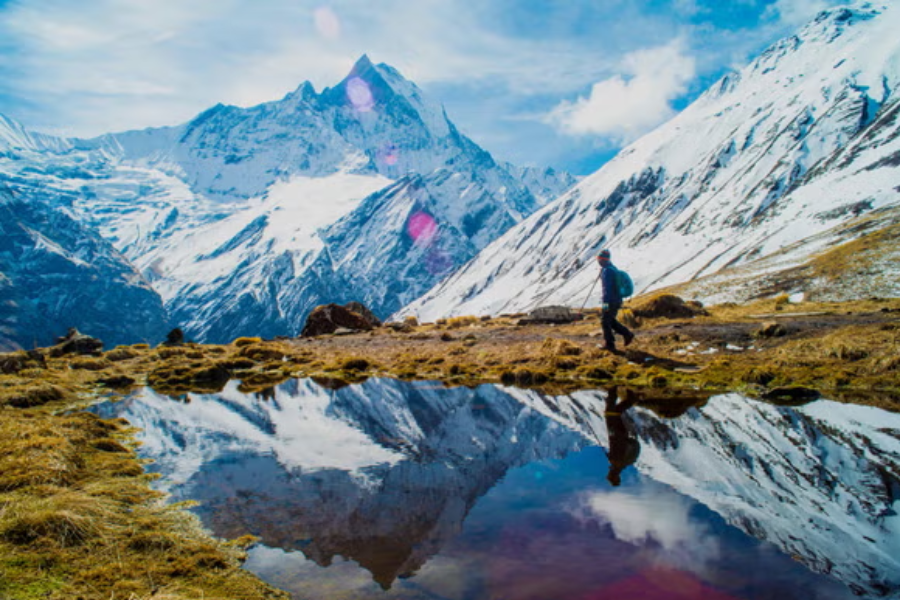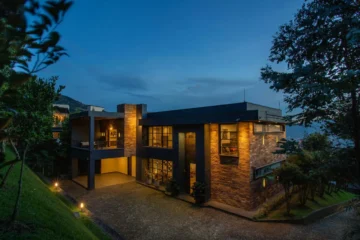Choosing the best time to visit Annapurna Base Camp (ABC) is essential for experiencing the trek’s stunning vistas and favorable conditions. The trek is renowned for its breathtaking views of the Annapurna Massif and other Himalayan peaks, but the experience can vary greatly depending on the season.
The primary trekking seasons in the Annapurna region are spring and autumn. Spring, from March to May, is one of the most popular times to undertake the Annapurna Base Camp trek 6 Days. During this period, the weather is generally stable with clear skies and moderate temperatures, which make for excellent trekking conditions. The lower elevations come alive with vibrant rhododendron blooms, creating a picturesque landscape filled with colors that contrast beautifully with the snow-capped peaks. This season offers a spectacular visual feast as the flowers add a lively contrast to the otherwise rugged terrain, enhancing the trek’s aesthetic appeal. Additionally, spring temperatures are pleasant, making the trek more comfortable and enjoyable.
Autumn, from September to November, is another prime time for the Annapurna Base Camp trek. This season is characterized by clear skies and crisp air, which provide some of the clearest views of the Himalayan peaks. The weather during autumn is generally dry and stable, with temperatures gradually cooling down after the monsoon. The clarity of the air means that the panoramic views of the Annapurna range, including Annapurna I, Machapuchare, and Dhaulagiri, are particularly spectacular. The trails are less crowded compared to spring, offering a more serene trekking experience and ample opportunity to fully appreciate the natural beauty of the region.
The winter months, from December to February, bring colder temperatures and heavy snowfall to the Annapurna region. While the snowy landscapes can be breathtakingly beautiful, the harsh conditions can make trekking challenging, with the risk of avalanches and treacherous paths. Winter treks are less common due to the increased difficulty and potential for extreme weather, but they offer a unique opportunity to experience the stark, serene beauty of the Himalayas in their winter guise.
Summer, or the monsoon season from June to August, is the least favorable time for the Annapurna Base Camp trek. This period is marked by heavy rainfall, which can lead to muddy and slippery trails, increased risk of landslides, and frequent cloud cover that obscures the views of the mountains. The monsoon season also brings high humidity, which can make trekking less comfortable and enjoyable.
In summary, the best times to visit Annapurna Base Camp for stunning views are during the spring and autumn seasons. Spring offers vibrant flora and moderate temperatures, while autumn provides clear skies and crisp air, ideal for unobstructed views of the majestic Himalayan peaks. Each season has its own charm, but spring and autumn are generally preferred for their optimal trekking conditions and breathtaking scenery.
Introduction
The 7 Day Annapurna Base Camp trek, one of Nepal’s most iconic trekking routes, is renowned for its stunning mountain vistas, diverse landscapes, and rich cultural experiences. Located in the heart of the Himalayas, this trek offers a unique opportunity to immerse oneself in the breathtaking beauty of the Annapurna Massif and its surrounding peaks. Choosing the right time to visit is crucial to maximizing your experience, as the trek’s conditions and vistas can vary significantly with the seasons. Each season brings its own set of characteristics, influencing the weather, trail conditions, and overall trekking experience. Understanding these seasonal changes helps trekkers plan their journey to enjoy the trek at its best, whether it’s the colorful blooms of spring, the crisp clear skies of autumn, or the unique challenges of winter or monsoon. This guide explores the Annapurna Base Camp trek in detail, focusing on the best times to visit and what to expect during each season.
Overview of the Annapurna Base Camp Trek
The Annapurna Base Camp trek is a captivating journey through diverse landscapes, from lush subtropical forests to high-altitude alpine meadows. The trek typically begins in the vibrant city of Pokhara, followed by a drive or flight to Nayapul. From there, trekkers embark on a route that gradually ascends through various altitudes, passing traditional villages, terraced fields, and dense forests. The highlight of the trek is reaching Annapurna Base Camp, situated at an altitude of 4,130 meters (13,550 feet), where trekkers are rewarded with panoramic views of the Annapurna Massif, including peaks like Annapurna I, Machapuchare (Fishtail), and Dhaulagiri. The trek usually spans 7 to 12 days, depending on the chosen itinerary, and offers a chance to experience the natural beauty and cultural richness of the region. Each season brings different conditions, making it essential for trekkers to select the timing that best aligns with their preferences and expectations.
Spring Season: March to May
Spring, from March to May, is one of the most favorable times to undertake the Annapurna Base Camp trek. During this period, the weather is generally stable, with moderate temperatures ranging from 10°C to 20°C (50°F to 68°F) at lower altitudes and cooler temperatures higher up. One of the key highlights of spring is the spectacular display of rhododendron blooms. The lower elevations of the trek are transformed into a vibrant landscape of pink, red, and white flowers, creating a picturesque contrast with the snow-capped peaks. This season also benefits from relatively clear skies and low humidity, making for excellent visibility of the Himalayan ranges. While the trails are popular during spring, the relatively stable weather conditions and stunning natural beauty make it a highly sought-after time for trekkers. Spring is ideal for those seeking a visually captivating trek with moderate temperatures and comfortable conditions.
Summer Monsoon: June to August
The summer monsoon season, from June to August, is generally considered the least favorable time for the Annapurna Base Camp trek. During this period, the region experiences heavy rainfall, which can lead to muddy and slippery trails, increased risk of landslides, and frequent cloud cover that often obscures the views of the mountains. The monsoon brings high humidity, which can make trekking uncomfortable and challenging. Additionally, the heavy rains can lead to trail closures and delays, as the increased water flow can cause rivers to swell and landslides to occur. While the lush green landscape during the monsoon can be stunning, the overall trekking experience can be less enjoyable due to the adverse weather conditions. Trekkers who do choose to trek during this period should be prepared for wet conditions and potential disruptions, and they may need to be flexible with their plans to accommodate changing weather patterns.
Autumn Season: September to November
Autumn, spanning from September to November, is another prime time for the Winter Annapurna Base Camp trek, offering some of the best conditions for trekking. During this period, the weather is generally stable and dry, with clear skies and crisp air providing excellent visibility of the Himalayan peaks. Temperatures range from 5°C to 20°C (41°F to 68°F), making for comfortable trekking conditions. The autumn season follows the monsoon, leaving the trails refreshed and the landscape lush and green. This time of year offers unobstructed views of the Annapurna Massif and surrounding peaks, making it ideal for capturing stunning photographs and enjoying panoramic vistas. The trails are popular during autumn, which can mean more trekkers on the route, but the clear weather and beautiful scenery often make it worth the crowds. Autumn is perfect for those seeking clear skies, vibrant landscapes, and ideal trekking conditions.
Winter Season: December to February
The winter season, from December to February, transforms the Annapurna region into a snow-covered wonderland, offering a unique but challenging trekking experience. During this time, temperatures can drop significantly, especially at higher altitudes. Daytime temperatures in the lower elevations can range from -5°C to 10°C (23°F to 50°F), while nighttime temperatures at higher altitudes, including Annapurna Base Camp, can plummet to -10°C to -15°C (14°F to 5°F). The trails are often covered in snow, which can create both breathtaking beauty and logistical challenges. Snow accumulation can obscure trails and make trekking more difficult, increasing the risk of avalanches and ice-related injuries. The winter months are less popular for trekking due to these harsh conditions, leading to fewer crowds and a more solitary experience. Despite the challenges, trekkers who are well-prepared for the cold can enjoy serene, snow-draped landscapes and clear, crisp air. This season also offers stunning, uninterrupted views of the Annapurna Massif and its surrounding peaks against a snowy backdrop, providing a different but equally captivating perspective of the Himalayas.
Weather Patterns and Temperature Changes
Weather patterns in the Annapurna region exhibit significant variation with the seasons, affecting trekking conditions and overall experience. During the spring (March to May) and autumn (September to November), the weather is generally stable, with mild temperatures and clear skies that provide excellent visibility of the Himalayan peaks. Spring brings moderate temperatures and vibrant flora, while autumn offers crisp air and dry conditions ideal for trekking. The summer monsoon season (June to August) is marked by heavy rainfall, high humidity, and the risk of landslides, which can make trekking challenging and muddy. Winter (December to February) introduces cold temperatures, snow, and icy conditions, with the potential for trail obstructions and increased risk of avalanches. Temperature changes can be extreme, particularly at higher altitudes, where conditions can shift rapidly. Understanding these weather patterns is crucial for planning a trek, as they influence trail conditions, safety, and overall trekking experience.
Best Times for Scenic Photography
The best times for scenic photography along the Annapurna Base Camp trek are during the spring and autumn seasons. In spring (March to May), the vibrant blooms of rhododendrons and other wildflowers create a colorful foreground against the majestic snow-capped peaks. The clear skies and moderate temperatures also offer excellent lighting conditions for capturing stunning landscape shots. Autumn (September to November) provides another optimal period for photography, with crisp air and clear skies enhancing visibility and allowing for striking views of the Annapurna Massif. The golden light of autumn, combined with the lush, post-monsoon greenery, creates ideal conditions for capturing breathtaking panoramas and intricate details of the landscape. Winter (December to February) offers dramatic snow-covered scenes, perfect for those who enjoy capturing the stark, serene beauty of snowy mountainscapes. However, the cold and snow can make photography more challenging. Each season has its own unique photographic opportunities, making the timing of your trek an important consideration for capturing the region’s beauty.
Avoiding Crowds: When to Trek
To avoid crowds on the Annapurna Base Camp trek, consider trekking during the winter months (December to February) or the early spring (March) and late autumn (November). Winter, while challenging due to cold temperatures and snow, typically sees fewer trekkers, offering a more solitary experience and quieter trails. The early spring and late autumn periods also tend to be less crowded than the peak spring (April to May) and autumn (September to October) seasons. By planning your trek during these less popular times, you can enjoy a more tranquil experience, with less congestion on the trails and at the base camp. However, it’s important to be prepared for the potential challenges of these off-peak times, such as colder temperatures or variable trail conditions. Trekking during these periods can provide a more serene and intimate experience with the natural beauty of the Annapurna region.
Considerations for Each Season
Each season on the Annapurna Base Camp trek presents unique considerations that can impact the overall experience. Spring (March to May) offers moderate temperatures, vibrant floral displays, and relatively stable weather, making it an excellent time for comfortable trekking and enjoying the region’s colorful scenery. However, it can be crowded due to its popularity. The summer monsoon (June to August) brings heavy rainfall, high humidity, and potential landslides, which can make trekking difficult and muddy, though it results in lush green landscapes. Autumn (September to November) provides clear skies, crisp air, and excellent visibility of the peaks, making it a popular choice for trekking with relatively fewer crowds compared to spring. Winter (December to February) offers serene, snow-covered landscapes and clear views but comes with harsh cold temperatures and challenging trail conditions. Each season requires specific preparation, from packing appropriate gear to adjusting trekking plans based on weather and trail conditions. By considering these factors, trekkers can choose the season that best aligns with their preferences and ensure a rewarding and safe trekking experience.
Packing Tips for Different Weather Conditions
Packing appropriately for the Short Annapurna Base Camp trek requires careful consideration of the season and weather conditions to ensure comfort and safety. In spring (March to May) and autumn (September to November), the weather is generally mild, but it’s still important to prepare for variable temperatures. Pack lightweight, breathable clothing for warmer daytime temperatures, along with layers that can be added for cooler mornings and evenings. A good quality rain jacket is essential, as spring and autumn can bring occasional showers. For trekking in summer monsoon (June to August), waterproof gear is crucial. Bring a durable, high-quality rain jacket, rain pants, and waterproof covers for your backpack. The trails can be muddy and slippery, so waterproof boots with good traction are also recommended. In winter (December to February), expect cold temperatures and snow, requiring heavier insulation. Pack thermal base layers, a down or synthetic insulated jacket, and warm, waterproof gloves. Insulated, waterproof boots with good traction are necessary for snowy conditions. Regardless of the season, always include a hat, sunglasses, sunscreen, and a first aid kit. Proper packing based on weather conditions enhances safety and comfort, ensuring a more enjoyable trekking experience.
Cultural Events and Festivals
The Annapurna region is rich in cultural traditions, and timing your trek to coincide with local festivals can offer a unique and enriching experience. During the spring, especially around April, you might encounter the vibrant festival of Dashain (also known as Vijaya Dashami), which is celebrated by Nepali Hindus with festivities, feasting, and rituals. This major festival involves family reunions, animal sacrifices, and cultural performances, providing insight into local traditions. In autumn, the festival of Tihar (Deepawali) is celebrated around October, marking the Hindu festival of lights. Tihar includes various rituals, such as the worship of dogs, cows, and the goddess Laxmi, with colorful decorations and communal celebrations. These festivals provide a chance to experience local culture, customs, and hospitality. When planning your trek, checking the local festival calendar and adjusting your itinerary accordingly can enhance your cultural experience and offer a deeper understanding of the region’s heritage.
Permits and Regulations by Season
Obtaining the necessary permits and understanding regulations are crucial for trekking in the Annapurna region. Regardless of the season, trekkers need to secure the Annapurna Conservation Area Permit (ACAP) and the Trekkers’ Information Management System (TIMS) card. The process for obtaining these permits remains consistent throughout the year. The ACAP helps in the conservation efforts of the Annapurna region, while the TIMS card ensures safety and monitoring of trekkers. During the peak trekking seasons of spring and autumn, permit offices and entry points might be busier, so it’s advisable to apply in advance or allow extra time for processing. In the winter and monsoon seasons, while the permit requirements remain the same, fewer trekkers might lead to a more streamlined process. Regardless of the time of year, it’s important to adhere to local regulations, respect natural and cultural sites, and follow guidelines set by authorities to ensure a safe and responsible trekking experience.
Health Considerations for Each Season
Health considerations for the Annapurna Base Camp trek vary with the seasons. During spring and autumn, with generally moderate weather conditions, health risks are relatively lower, though trekkers should still be mindful of altitude sickness and proper hydration. In spring, the increase in pollen and blooming plants might affect those with allergies. Autumn, with its dry conditions, can lead to respiratory issues if the air is dusty. The monsoon season brings high humidity and increased risk of gastrointestinal issues due to the consumption of untreated water. It’s essential to drink purified water and maintain good hygiene. Winter presents more severe health risks, including hypothermia and frostbite, due to cold temperatures. Proper warm clothing and careful management of exposure to the cold are critical. Regardless of the season, acclimatization is vital to prevent altitude sickness, and trekkers should ascend gradually and heed their body’s signals. Adequate preparation for seasonal health risks ensures a safer and more comfortable trekking experience.
Conclusion: Choosing Your Optimal Trekking Time
Selecting the optimal time for the Annapurna Base Camp trek involves balancing your preferences for weather conditions, crowd levels, and personal interests. Spring (March to May) offers a vibrant landscape with blooming rhododendrons and moderate weather, making it an excellent time for enjoying colorful scenery and comfortable trekking conditions. Autumn (September to November) provides clear skies, crisp air, and optimal visibility of the Himalayan peaks, with fewer crowds compared to spring, making it ideal for stunning panoramic views and a tranquil trekking experience. Summer monsoon (June to August) brings challenges with heavy rainfall and muddy trails but also a lush green landscape for those seeking a more adventurous trek. Winter (December to February) offers a serene, snow-covered environment with minimal crowds but requires preparation for cold and snowy conditions. By considering these factors and aligning them with your trekking goals, you can choose the best time to experience the Annapurna Base Camp trek according to your preferences and ensure a memorable adventure.
Keep up-to-date with breaking news and updates on infosekker




